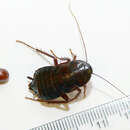en
names in breadcrumbs


The species Periplaneta americana, the Oriental Cockroach, is also known as the black beetle or the water bug. It is very common all over the world, and is the most common urban roach in England. Because of the danger that it poses, people try to eliminate it. One of the methods used to get rid of the cockroach is to use insecticides. However, this roach has a resistence to certain insecticides and because there are so many roaches, it is difficult to exterminate them (Ogg et al 1996, Bull's Pest Control, Inc. 1999).
Periplaneta americana is anything but endangered. In fact, there are various measures being taken in order to rid the world of this species. The Oriental Cockroach is unwanted everywhere. In order to rid themselves of it, people should to keep their homes clean, reduce the food that is available to it, use chemical control (including aerosols, dusts, etc), and place sticky traps in order to control those that are indoors (Ogg et al. 1996 ).
US Federal List: no special status
CITES: no special status
State of Michigan List: no special status
Periplaneta americana is thought by many to be the dirtiest of pests that invade and infest homes. This roach can ruin food and also produces a smelly odor. By moving back and forth between garbage and human food, it contaminates the food with diseases that can lead to many illnesses, including food poisoning, dysentery, diarrhea, and others. It is also believed that exposure to roach waste and skin fragments in the air is a cause of some cases of childhood asthma. It is considered to be the 6th worse pest in the world (Cornwell 1976; Lyon 2000).
No known benefit.
This species is an omnivorous one, meaning that it eats animals, plants, or anything that is available for it to consume. Since Periplaneta americana does not have mouthparts that are specialized to eat certain things, it can eat hard or soft materials and can drink any kind of liquid. However, it mostly feeds on garbage or any sort of decaying organic matter, although its favorite foods consist of anything that is either sugary or starchy. This cockroach invades homes and eats whatever is left out, which poses a danger because it can contaminate the food that it touches, leaving infectious material for the human living in that home. This cockroach can survive one month without eating, as long as it consumes water. If there is no water, then fresh fruits are a good source of liquid for it to drink. However, it will die in two weeks if it is not provided with either food or water (Cornwell 1968; Lyon 2000).
Periplaneta americana, the Oriental Cockroach, is common world-wide. There is no country that is free of the presence of this insect. Combined with Blatta germanica, the Oriental Cockroach is present in approximately ten per cent of properties in areas all over the world (Cornwell 1968). Despite their name, Periplaneta americana is thought to have originated in Africa.
Biogeographic Regions: nearctic (Introduced ); palearctic (Introduced ); oriental (Introduced ); ethiopian (Native ); neotropical (Introduced ); australian (Introduced ); oceanic islands (Introduced )
The Oriental Cockroach is found both outdoors and indoors. It can be found outside during warm weather in trash cans, sewers, or even under old leaves or stones. In Asia it has been found in caves where bats live. During autumn, however, Oriental Cockroaches may move in large groups into unheated buildings, since they prefer a cooler environment. The preferred temperature ranges from about twenty to twenty-nine degrees Celsius. It is more unlikely to find Periplaneta americana in higher level floors on buildings. Most likely it will be found in the first floor of a building. It likes damp areas and will live in damp basements, near water pipes, leaky drains, or any similar areas (Cornwell 1968; Lyon 2000, Ogg et al. 1996).
The adult Oriental Cockroach is a shiny black or dark-brown color. The younger members are darker and not shiny like the adults. The male of Periplaneta americana is smaller than the female. Males are about 2.6 centimeters in length, while females tend to be from 2.6 to 3.25 centimeters in length. The average male weighs approximately .45 grams while the female weighs .95 grams. The male is also more slender than the female, whose abdomen is broad in comparison to his. Another difference between the male and female of the species is that while the male has wings that almost reach the abbomen, the female only has pads as her wings. Although both have wings or pads, neither can fly. The nymphs have a similar shape to the adults, but unlike the adults, are wingless (Cornwell 1976; Lyon 2000).
Range mass: .45 to .95 g.
Other Physical Features: ectothermic ; bilateral symmetry
The female of the species Periplaneta americana produces from one to eighteen red/brown egg cases during her life: about one case per month. These cases are about 1 cm long, .65 cm wide, and contain an average of fourteen eggs. They can, however, contain up to sixteen eggs each. A capsule is carried by the female cockroach anywhere from twelve hours to five days until she places it somewhere where there is food and warmth. It is also very important to place them somewhere where they will be safe. The female of this species, unlike some other roach species, does not help her offspring. After she deposits the eggs, it takes about two months for them to hatch, but it takes approximately twelve months for the nymphs to be fully developed. Most of these roaches are adults when fall comes, but the adults live only from one to six months (Lyon 2000; Bull's Pest Control, Inc. 1999, Ogg et al. 1996).